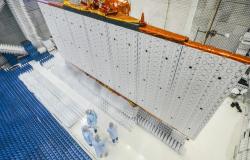The past of our galaxy, the Milky Way, is paved with many movements with other galaxies, sometimes through violent collisions when approaching, colliding and being torn apart and devoured by our own. Now, a team of astronomers from the Rensselaer Polytechnic Institute exposes, in their latest study published in the journal Monthly Notices of the Royal Astronomical Societythat the most recent of those cosmic collisions occurred billions of years later than previously thoughtwhich suggests that our galaxy is much younger than we thought.
They discover that the last collision of the Milky Way occurred very recentlyMidjourney/Sarah Romero
The past of the galaxy
“We become more wrinkled as we age, but our work reveals that the opposite is true in the Milky Way. “It’s a kind of cosmic Benjamin Button, becoming less wrinkled over time,” says Thomas Donlon, an astronomer at Rensselaer Polytechnic Institute and the University of Alabama and lead author of the research. “By watching these wrinkles dissipate over time, We can track when the Milky Way experienced its last major collapseand it turns out that this happened billions of years later than we thought.”
When did the last big merger take place? Scientists believed that the last major merger of the Milky Way was quite remote; between 8,000 and 11,000 million years ago. But it seems that it was much more recent: less than 3,000 million years ago. This recent collision would place it long after the formation of the Earth.

Cosmic wrinkles
Thanks to the data of the Gaia telescope, which is able to accurately pinpoint the position and motion of more than 100,000 local stars in the solar system within the entire catalog of stellar bodies on monitors, everything indicates that the Milky Way would have cannibalized a smaller galaxy in the recent past ( in cosmic terms, of course) after focusing on the ‘wrinkles’ of the galaxy, which are formed when other galaxies collide with the Milky Way. By measuring the positions and velocities of these stars with great precision, Gaia can detect wrinkles, the trace of the last great fusion. By studying how these wrinkles dissipate, the team plotted the timeline of the last major collision.
“For the stars’ wrinkles to be as clear as they appear in the Gaia data, they must have joined us less than three billion years ago, at least five billion years later than previously thought,” said Heidi Jo Newberg, co-author of the work. “Every time the stars swing back and forth through the center of the Milky Way, new star wrinkles form. “If they had joined us eight billion years ago, there would be so many wrinkles next to each other that we would no longer see them as separate features.”
This image visualizes our Milky Way and the halo of stars that surrounds it.SA / Gaia / DPAC / Donlon et al. / Stefan Payne-Wardenaar.
The team introduced a new metric called “causticality” in the simulations, which measures the inequality in the phase space distribution of stars. A high causticity value indicates a more recent collision, in which the stars have not yet completely mixed, and, on the other hand, a low causticity value indicates that the collision is more remote. They then compared the observations with data from simulations and found a match on a timeline from about 1 billion to 2 billion years ago. The high causticity observed in the Gaia data points to a much more recent merger.
“If they had joined us eight billion years ago, there would be so many wrinkles next to each other that we would no longer see them as separate features,” the experts say. Therefore, this discovery suggests that, rather than these stars originating from the ancient Gaia-Sausage-Enceladus merger, they must have come from a more recent event called the Virgo Radial Merger, which took place less than 3 billion years ago. .
New findings from the Gaia space telescope indicate that the Milky Way may have cannibalized a small galaxy not long ago, cosmically speaking.Midjourney/Sarah Romero
“The history of the Milky Way is constantly being rewritten, largely thanks to new data from Gaia. Our picture of the Milky Way’s past has changed dramatically from even a decade ago, and I think our understanding of these mergers will continue to change quickly,” the researchers say.
If confirmed, these findings could significantly affect our understanding of the formation of the Milky Way. But this does not mean that there is no evidence of the oldest merger, since there are many stars that could be associated with both events; some related to the old merger and others to the most recent one. And for astronomers, it is quite a challenge to discover it.
“Future exploration will reveal which of these smaller objects previously thought to be related to an ancient Gaia-Sausage-Enceladus (GSE)they are actually related to a Virgo Radial Fusion most recent,” they conclude.
The future of the galaxy will not be much different. The Milky Way is destined to engulf its two satellite galaxies, the Large and Small Magellanic Clouds that will end up being absorbed by our galaxy.
Wrinkles were first identified in Gaia data in 2018Midjourney/Sarah Romero
References:
- Thomas Donlon et al, The debris of the ‘last major merger’ is dynamically young, Monthly Notices of the Royal Astronomical Society (2024). DOI: 10.1093/mnras/stae1264






